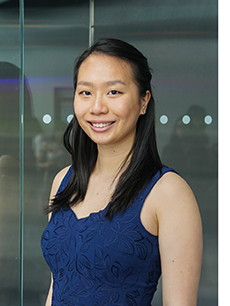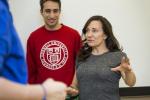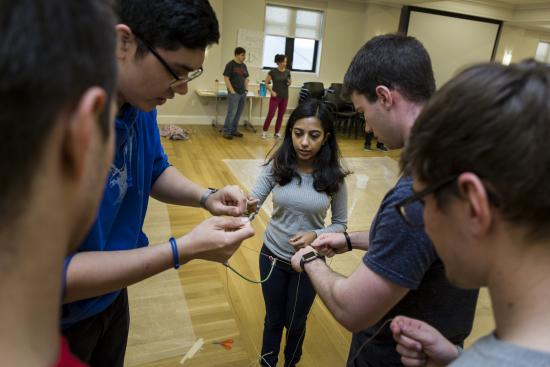Program Transforms Engineers from Learners to Leaders
By Syl Kacapyr
When Jerica Huang ’18 first set foot on Cornell’s campus, she was by most standards a typical engineering student: a computer science major with an affinity for math, a bit reserved, passing her time by studying and competing in hackathons. But on the inside dwelled another persona.
So when less than a year later she found herself competing in the 2015 Miss New Jersey USA Ambassador Pageant, an event she describes as the most nerve-wracking thing she’s ever done, it was clear there had been a revelation in her life.
That revelation was the Cornell Engineering Leadership Program, an initiative launched in 2012 to provide a number of opportunities for students to tap their inner strengths while also building new leadership skills. With only two full-time staff members, the program has grown to reach 80 percent of all Cornell Engineering students today.
“There’s just a real hunger for this kind of education,” said Erica Dawson Ph.D. ‘04, the Nancy and Bob Selander Director of the program. “So many of our students are involved in project teams and leadership opportunities. The other thing I think there’s a hunger for is impact. They’re very multifaceted and they want to do big things. They’re asking themselves, ‘how can I be this person that can have a huge impact on the world?’”
 Huang had asked herself that very question after coding opened her eyes to the potential computer science has to make a tangible impact on people’s lives. Through the course of one of the leadership program’s offerings, Huang realized that she needed to challenge herself to have more of a voice, and that’s when she guardedly entered the pageant. To her surprise, she won.
Huang had asked herself that very question after coding opened her eyes to the potential computer science has to make a tangible impact on people’s lives. Through the course of one of the leadership program’s offerings, Huang realized that she needed to challenge herself to have more of a voice, and that’s when she guardedly entered the pageant. To her surprise, she won.
“Pageantry became my platform to advocate for the causes I care deeply about, such as ending the stigma surrounding mental illnesses and promoting Girls Who Code,” said Huang, referring to the non-profit organization that encourages young women interested in computer science. Huang has since continued competing in pageants and switched her major to information science, systems and technology—a move she says will help her best prepare for a leadership role in her career.
“She’s gotten so much out of this program and given so much back,” said Dawson. “She just really blows me away.”
Dawson has been impressed with many of her students’ new-found personal and professional skills—skills that are now considered essential assets for today’s working engineers expected to manage projects, lead working groups, teach students, inform policy or start their own company. Through the Leadership Program, students prepare for those professional responsibilities by embracing them as undergraduates.
MODERN SKILLS FOR MODERN ENGINEERS
The Cornell Engineering Leadership Program has roots in the business world, where leadership is a trait that has long been valued and students are generally offered a number of courses, programs and opportunities to learn those skills in a classroom environment.
Lance Collins, the Joseph Silbert Dean of Engineering, saw the need for providing those same opportunities to engineering students after overseeing several student project teams during his tenure as director of the Sibley School of Mechanical and Aerospace Engineering. “I was often amazed at the quality of leadership that the students were able to show, but on occasion, there were times when some of the teams had some difficulties and it occurred to me that it would be great for us to have a more structured way of teaching the students about leadership.”
So naturally Collins turned to someone with experience in business education. Dawson had previously been an assistant professor of management and organizations at Yale University and at the Rady School of Management in San Diego. When she arrived at Cornell, financial support from alumnus Charles S. Brown Jr. ‘72, ‘73 M.Eng. and an anonymous donor helped launch the leadership program. Dawson’s first order of business was to establish programming that catered to the needs of engineers, a group she was not familiar with at the time, but quickly came to understand.
“I don’t think different models of leadership fundamentally apply to different fields. So you can take a model of leadership and it applies to engineers just as well as anybody else,” said Dawson. “But the big difference is how engineers learn. So you can’t just take an M.B.A. program and plop it in the College of Engineering and have it be successful.”
Dawson is currently writing an academic report that highlights her findings regarding how engineers learn. “I reject the stereotype that engineers are like introverted nerds and that they don’t have any people skills. That’s just not true. What we do know is they’ve self-selected into a field that is very oriented toward problem solving that rejects ambiguity. They like clear right or wrong answers. And they don’t get a lot of training, or previously didn’t, on personal and professional skills. So by the time you see professional engineers, they can appear introverted, but that’s just because they haven’t had that kind of training,” said Dawson.
Professional skills can be misconstrued in both engineering and business, according to Robert Selander ‘72, former CEO of MasterCard. Selander has given $6 million to blossom the Cornell Engineering Leadership Program from its beginning stages to its next evolution, endowing an associate director position that Dawson says will allow new offerings and opportunities for students. Selander says a lack of communication skills can sometimes be associated with a lack of competency, even though that isn’t the case. “Early in my career I had the chance to work in several countries. I recall visiting branches in Brazil and realizing that judging the capabilities and insights of individuals based on their English language skills—I was still struggling with their native Portuguese—could lead to bad calls on relative capabilities and potential,” said Selander.
“Some people do come with a set of skills that’s a little more oriented toward leadership, but a lot of it is you’re just being rewarded for being outgoing and confident,” said Dawson. “And it looks like in the end some people have it and some people don’t. If we go on that model, we’re missing all of the students who maybe don’t fit the stereotype of a leader. These are the quieter students, the people who wouldn’t consider themselves leaders. That’s who I’m here to serve.”

BUILDING A PROGRAM
In its first five years, the Cornell Engineering Leadership Program has grown to include a number of courses, a certificate program, individualized consulting and has fused itself into a number of existing courses.
Dawson has built the program around what she calls the four pillars of leadership—knowledge, experience, insight, courage—all while maintaining a hands-on, problem-solving curriculum that engineers have a propensity for.
“It’s a chance for personal reflection and development grounded in values and ethics, and at the other end is: here are the skills of a manager, here’s how you run a meeting, how you manage a project,” explained Dawson, highlighting the importance of introspect and tangible skills in leadership training. “We cover both of those things and I think that is what makes us unique here at Cornell.”
Students are exposed to the program early, with faculty inviting Dawson into freshman advising seminars to discuss the importance of teamwork—something that is universally recognized as an essential aspect of engineering. The encounter also gives Dawson the opportunity to share other offerings, such as the Engineering Leadership Certificate Program. The highly selective, one-year program for undergraduates requires two courses that cover competencies in self management, teamwork, leadership and professional skills.
The certificate program also requires students to work in small groups to design and implement a project related to their interests. In 2016, a group created a network between Cornell and the greater Ithaca community by organizing, recruiting and transporting students to volunteer at the Ithaca Children’s Garden and the Jenkins Center for Hope and Recovery. “In the case of our project, we had to get other people on board with us. And so that’s one aspect of leadership: you have to be passionate about what you’re doing in order to be able to inspire others to follow you. And I think that’s one thing we developed through this project,” said Esther Chen ‘18, a biomedical engineering major and a member of the group that created the volunteer network.
Another group engineered solar-powered composters and worked with a local high school to install them on school grounds. The group included an educational component that helped the high school students revitalize existing composting efforts. Like other groups in the certificate program, the students who built the composters were required to raise the necessary funds on their own. But Dawson says support from the Selanders now allows her to offer seed funding when student groups are able to develop a budget and justification for it.
Graduates of the program earn a designation on their transcript recognizing demonstrated excellence in engineering leadership. Some of those graduates return to the program as mentors, working peer-to-peer with the program’s new students.
Dawson teaches a third course outside of the certificate program that focuses on women in the workplace. Although the course is offered by the SC Johnson College of Business, typically about a third of the enrollees are engineering students. It’s geared toward both male and female students, and explores the challenges of managing gender diversity and best practices for attracting and leveraging female talent.
“It’s really any field where you have a male majority. For women, there’s going to be those hurdles. And that’s also true for underrepresented minorities,” said Dawson, who adds that her office works with the office of Diversity Programs in Engineering to develop and update the curriculum. “We’re trying to work more with them on what it is to be underrepresented in your group. So if I’m the solo, fill in the blank, African American or woman in my group, how are other people likely to see me and interact with me, and what can I do about that?”

COLLABORATIVE TEACHING
Dawson concedes that few students are able to squeeze additional courses into their packed class schedules, so she has expanded the reach of her program by finding courses where students are already working in teams and integrating leadership skills into those experiences. Dawson calls the effort “collaborative teaching,” and it’s another attribute that makes Cornell unique among engineering leadership programs.
One of those courses is ECE 3400 Electrical and Computer Engineering Practice and Design, in which students work in teams throughout the semester to design and build a system. Last year the course concluded with a competition in which robots built by the undergraduate teams had to autonomously navigate and map labyrinths in the shortest amount of time.
“We’re working with professors to make some small adjustments to the way those teams are run so students can get a lot more out of that experience,” said Dawson. That includes selecting team members using a novel software— developed at Cornell by Kathy Dimiduk ’79, director of the James McCormick Family Teaching Excellence Institute—that’s designed to form healthy, well-functioning teams based on social science research. “So the software knows not to isolate women or unrepresented minorities, for instance. It looks at a number of different metrics and based on social science, it forms a team that will have the highest chance for success,” added Dawson.
In the case of ECE 3400, Dawson’s office also gave guest lectures on team skills and encouraged the student teams to craft and sign group contracts with team goals and ground rules. Charles Seyler, a professor of electrical and computer engineering who taught the course when the Leadership Program first intervened, says the team performances were much more uniform than in pervious years, with the gap between the best and worst performing teams diminished.
Higher participation rates in the course’s final presentations were also observed and end-of-semester questionnaires submitted by the students revealed positive interactions between team members. “From my direct experience as a professor in a course that benefited from the Engineering Leadership Program as well my observations of results from other components of the program, I’m a very enthusiastic supporter,” said Seyler. “The program has great value for our students. Teamwork and leadership skills are essential to being a productive engineer in today’s workplace.”
Despite the reach of the program, Dawson says her office still isn’t able to meet the demand for leadership training. In the case of the certificate program, her office turns away three students for everyone one that it accepts. But as the program continues to grow, so too will opportunities for students.
“We’re trying to have as big of an impact as possible with a small staff,” Dawson said, noting that her office recently hired its second full-time employee, Rob Parker, the Nancy and Bob Selander Associate Director. The program is already having a larger impact because of Parker, who is designing leadership software of his own while also working one-on-one with student project teams, providing coaching and customized consulting.
As she discussed her vision for the program’s future, a smile grew on Dawson’s face and she uttered the words one might expect to hear from a true leader: “I have big dreams.”

